Design and Evaluation of an Adjustable Compliant Constant-Force Microgripper
Abstract
:1. Introduction
2. Theoretical Model
2.1. Theoretical Model of Negative Stiffness Mechanism
2.2. Theoretical Model of Positive Stiffness Mechanism
2.3. Theoretical Model of Compliant-Force Mechanism
3. Design of Microgripper
3.1. The Establishment of the Preliminary Model
3.1.1. Parameter Selection of the Preliminary Model
3.1.2. Simulation and Test of the Preliminary Model
3.2. Automatic Optimization of Constant-Force Mechanism
3.2.1. Optimization Objective
3.2.2. Constant-Force Performance Evaluation
3.2.3. Automatic Parameter Optimization
3.3. Design of Adjustable Compliant Constant-Force Microgripper
4. Simulation and Experimental Verification
4.1. FEA Simulation
4.2. Experimental Verification
4.2.1. Experimental Setup
4.2.2. Mechanical Properties of Adjusting Module
4.2.3. Mechanical Properties of Microgripper
5. Conclusions
Author Contributions
Funding
Data Availability Statement
Conflicts of Interest
References
- Huang, Y.; Vasan, A.S.S.; Doraiswami, R.; Osterman, M.; Pecht, M. MEMS Reliability Review. IEEE Trans. Device Mater. Reliab. 2012, 12, 482–493. Available online: https://ieeexplore.ieee.org/stamp/stamp.jsp?tp=&arnumber=6171839 (accessed on 12 February 2021). [CrossRef]
- Liu, S.; Li, Y.F.; Xing, D. Sensing and control for simultaneous precision peg-in-hole assembly of multiple objects. IEEE Trans. Autom. Sci. Eng. 2019, 7, 310–324. Available online: https://ieeexplore.ieee.org/stamp/stamp.jsp?tp=&arnumber=8794556 (accessed on 16 March 2022). [CrossRef]
- Wang, G.; Xu, Q. Design and precision position/force control of a piezo-driven microinjection system. IEEE/ASME Trans. Mechatron. 2017, 22, 1744–1754. Available online: https://ieeexplore.ieee.org/stamp/stamp.jsp?tp=&arnumber=7912296 (accessed on 19 April 2022). [CrossRef]
- Leveziel, M.; Haouas, W.; Laurent, G.J.; Gauthier, M.; Dahmouche, R. Migribot: A miniature parallel robot with integrated gripping for high-throughput micromanipulation. Sci. Robot. 2022, 7, 4292. Available online: https://www.science.org/doi/full/10.1126/scirobotics.abn4292 (accessed on 30 April 2023). [CrossRef] [PubMed]
- Liang, H.; Qiao, J. Analysis of Current Situation, Demand and Development Trend of Casting Grinding Technology. Micromachines 2022, 13, 1577. [Google Scholar] [CrossRef] [PubMed]
- Xie, H.; Meng, X.H.; Zhang, H.; Sun, L. Development of a Magnetically Driven Microgripper for PicoNewton Force-Controlled Microscale Manipulation and Characterization. IEEE Trans. Ind. Electron. 2020, 67, 2065–2075. Available online: https://ieeexplore.ieee.org/stamp/stamp.jsp?tp=&arnumber=8672921 (accessed on 3 January 2022). [CrossRef]
- Xu, Q. Adaptive Discrete-Time Sliding Mode Impedance Control of a Piezoelectric Microgripper. IEEE Trans. Robot. 2013, 29, 663–673. Available online: https://ieeexplore.ieee.org/stamp/stamp.jsp?tp=&arnumber=6423296 (accessed on 14 June 2022). [CrossRef]
- Wang, J.Y.; Lan, C.C. A Constant-Force Compliant Gripper for Handling Objects of Various Sizes. J. Mech. Des. 2014, 136, 071008. [Google Scholar] [CrossRef]
- Lobontiu, N. Compliance-based modeling and design of straight-axis/circular-axis flexible hinges with small out-of-plane deformations. Mech. Mach. Theory 2014, 80, 166–183. [Google Scholar] [CrossRef]
- Qin, X.; Lu, S.; Liu, P.; Yan, P. Design and Testing of a Novel Nested, Compliant, Constant-Force Mechanism with Millimeter-Scale Strokes. Micromachines 2023, 14, 480. [Google Scholar] [CrossRef]
- Liu, T.; Hao, G. Design of a Cylindrical Compliant Linear Guide with Decoupling Parallelogram Mechanisms. Micromachines 2022, 13, 1275. [Google Scholar] [CrossRef] [PubMed]
- Wang, P.; Xu, Q. Design and modeling of constant-force mechanisms: A survey. Mech. Mach. Theory 2018, 119, 1–21. [Google Scholar] [CrossRef]
- Wang, W.J.; Yu, Y.Q. New Approach to the Dynamic Modeling of Compliant Mechanisms. Mech. Robot. 2010, 2, 021003. [Google Scholar] [CrossRef]
- Ma, F.L.; Chen, G.M. Modeling Large Planar Deflections of Flexible Beams in Compliant Mechanisms Using Chained Beam-Constraint-Model. Mech. Robot. 2016, 8, 021018. [Google Scholar] [CrossRef]
- Midha, A.; Bapat, S.G.; Mavanthoor, A. Analysis of a Fixed-Guided Compliant Beam with an Inflection Point Using the Pseudo-Rigid-Body Model Concept. Mech. Robot. 2015, 7, 031007. [Google Scholar] [CrossRef]
- Chen, Y.H.; Lan, C.C. An Adjustable Constant-Force Mechanism for Adaptive End-Effector Operations. J. Mech. Des. 2012, 134, 031005. [Google Scholar] [CrossRef]
- Kuo, Y.L.; Lan, C.C. A Two-Dimensional Adjustable Constant-Force Mechanism. J. Mech. Des. 2020, 142, 063304. [Google Scholar] [CrossRef]
- Chen, C.C.; Lan, C.C. An Accurate Force Regulation Mechanism for High-Speed Handling of Fragile Objects Using Pneumatic Grippers. IEEE Trans. Autom. Sci. Eng. 2017, 15, 1600–1608. Available online: https://ieeexplore.ieee.org/stamp/stamp.jsp?tp=&arnumber=8077767 (accessed on 26 July 2022). [CrossRef]
- Zhang, X.; Wang, G.; Xu, Q. Design, Analysis and Testing of a New Compliant Compound Constant-Force Mechanism. Actuators 2018, 7, 65. [Google Scholar] [CrossRef]
- Ye, T.; Ling, J.; Kang, X.; Feng, Z.; Xiao, X. A Novel Two-Stage Constant Force Compliant Microgripper. J. Mech. Des. 2021, 143, 053302. [Google Scholar] [CrossRef]
- Zuoshan, L.; Li, Y. Application of Multi-Objective Optimization Problem Based on Genetic Algorithm. J. Phys. Conf. Ser. 2021, 2037, 012021. Available online: https://iopscience.iop.org/article/10.1088/1742-6596/2037/1/012021/pdf (accessed on 17 August 2023). [CrossRef]
- Choi, K.B.; Lee, J.J.; Hata, S. A piezo-driven compliant stage with double mechanical amplification mechanisms arranged in parallel. Sens. Actuators A Phys. 2010, 161, 173–181. [Google Scholar] [CrossRef]
- Tian, Y.; Shirinzadeh, B.; Zhang, D. A flexure-based mechanism and control methodology for ultra-precision turning operation. Precis. Eng. 2009, 33, 160–166. [Google Scholar] [CrossRef]
- Wang, F.J.; Huo, Z.C.; Liang, C.M. A Novel Actuator-Internal Micro/Nano Positioning Stage With an Arch-Shape Bridge-Type Amplifier. IEEE Trans. Ind. Electron. 2019, 66, 9161–9172. Available online: https://ieeexplore.ieee.org/stamp/stamp.jsp?tp=&arnumber=8575132 (accessed on 23 September 2021). [CrossRef]
- Xu, Q.; Li, Y. Analytical modeling, optimization and testing of a compound bridge-type compliant displacement amplifier. Mech. Mach. Theory 2011, 46, 183–200. [Google Scholar] [CrossRef]
- Ma, F.; Chen, G. Bi-BCM: A Closed-Form Solution for Fixed-Guided Beams in Compliant Mechanisms. Mech. Robot. 2017, 9, 014501. [Google Scholar] [CrossRef]
- Wang, P.; Xu, Q. Design of a flexure-based constant-force XY precision positioning stage. Mech. Mach. Theory 2017, 108, 1–13. [Google Scholar] [CrossRef]
- Xu, Q. Design of a Large-Stroke Bistable Mechanism for the Application in Constant-Force Micropositioning Stage. J. Mech. Robot. Trans. ASME 2017, 9, 011006. [Google Scholar] [CrossRef]
- Tong, Z.; Wang, G. Automatic Optimization for Compliant Constant Force Mechanisms. Actuators 2023, 12, 61. [Google Scholar] [CrossRef]
- Xu, Q. Design and testing of a novel XY micropositioning stage with dual ranges and resolutions. In Proceedings of the 2014 IEEE International Conference on Robotics and Automation (ICRA), Hong Kong, China, 31 May–7 June 2014; Available online: https://ieeexplore.ieee.org/stamp/stamp.jsp?tp=&arnumber=6907185 (accessed on 19 August 2023).
- Xu, Q. New Flexure Parallel-Kinematic Micropositioning System with Large Workspace. IEEE Trans. Robot. 2012, 28, 478–491. Available online: https://ieeexplore.ieee.org/stamp/stamp.jsp?tp=&arnumber=6087290 (accessed on 20 October 2021). [CrossRef]

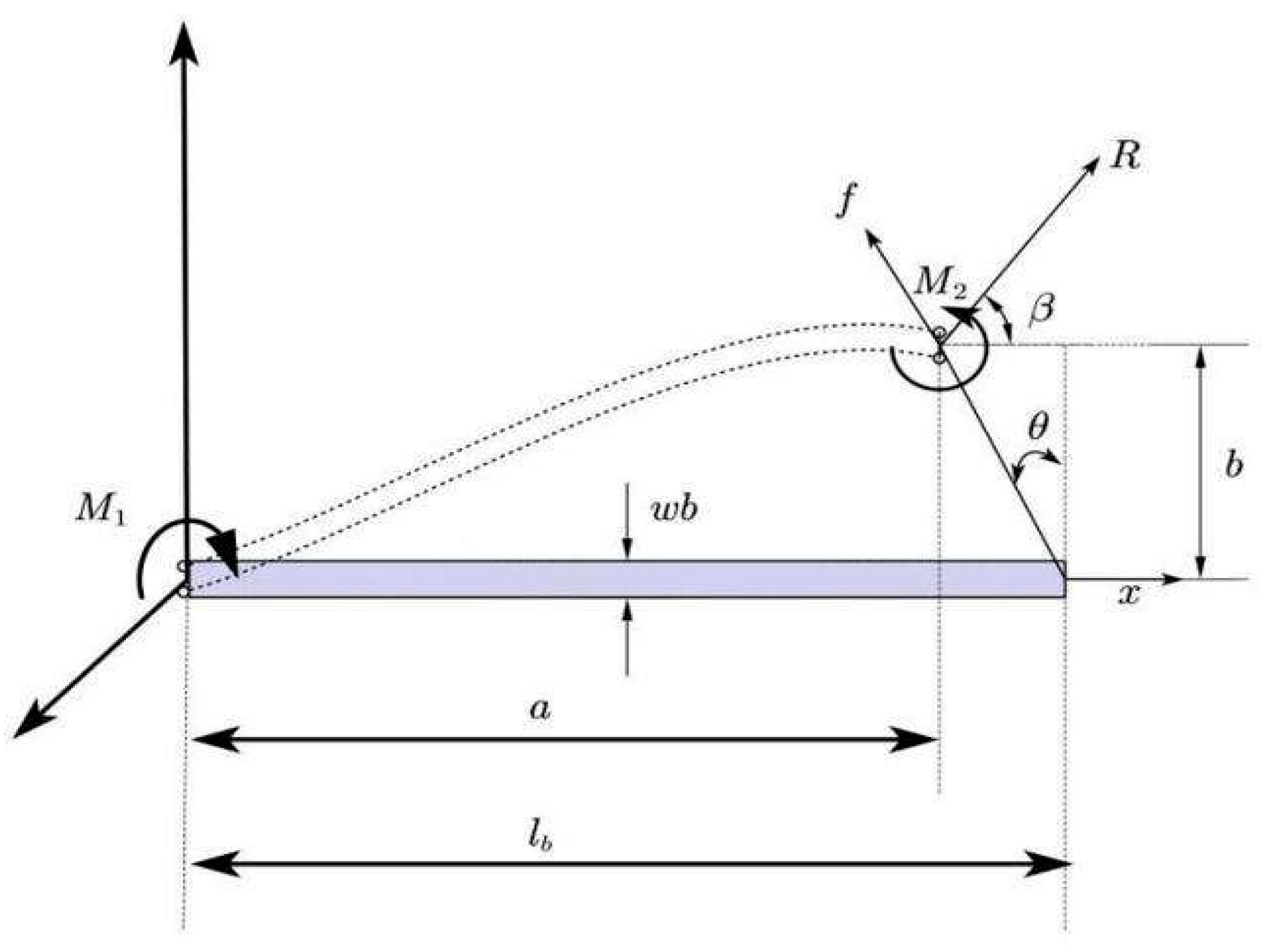

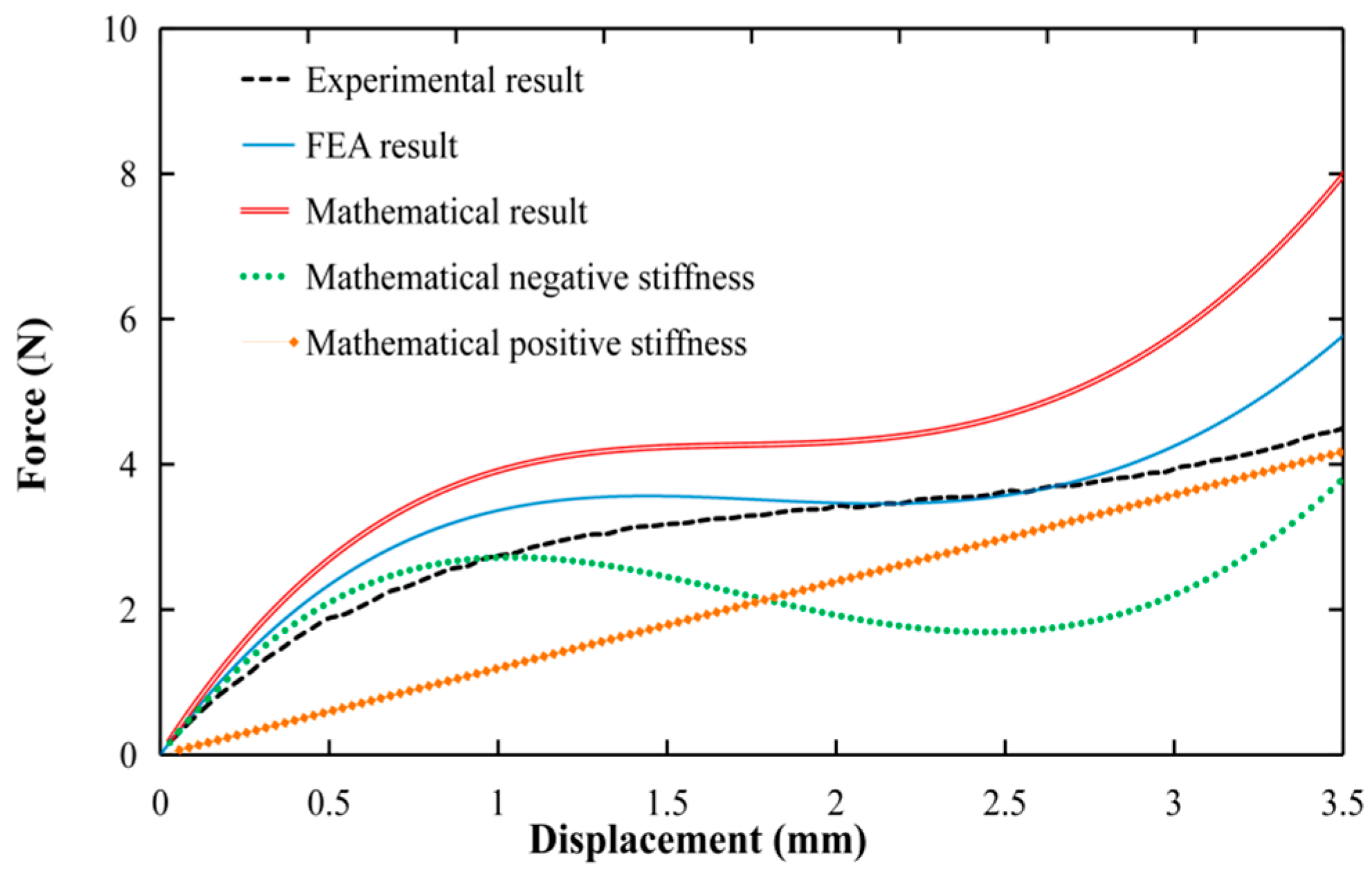
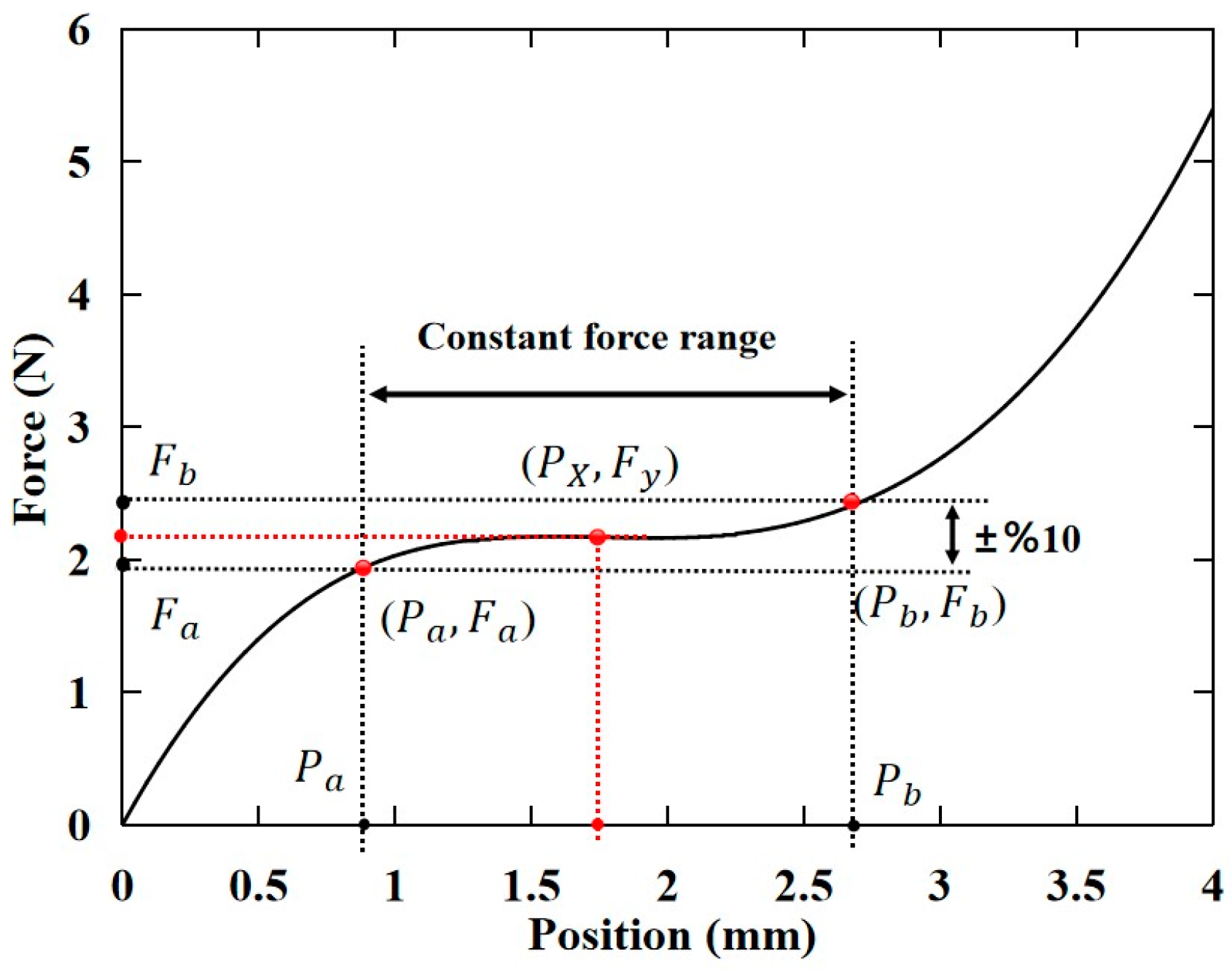
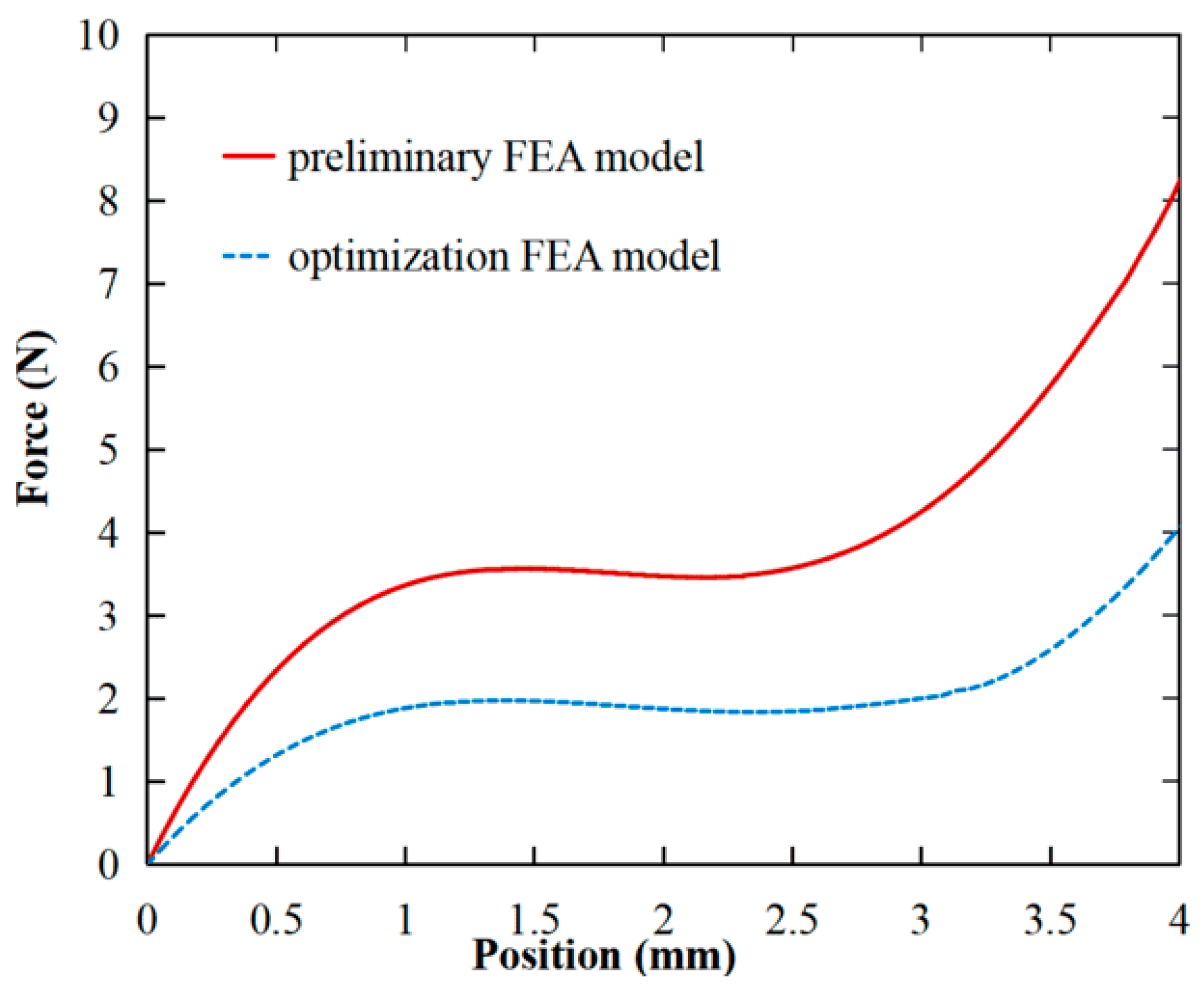

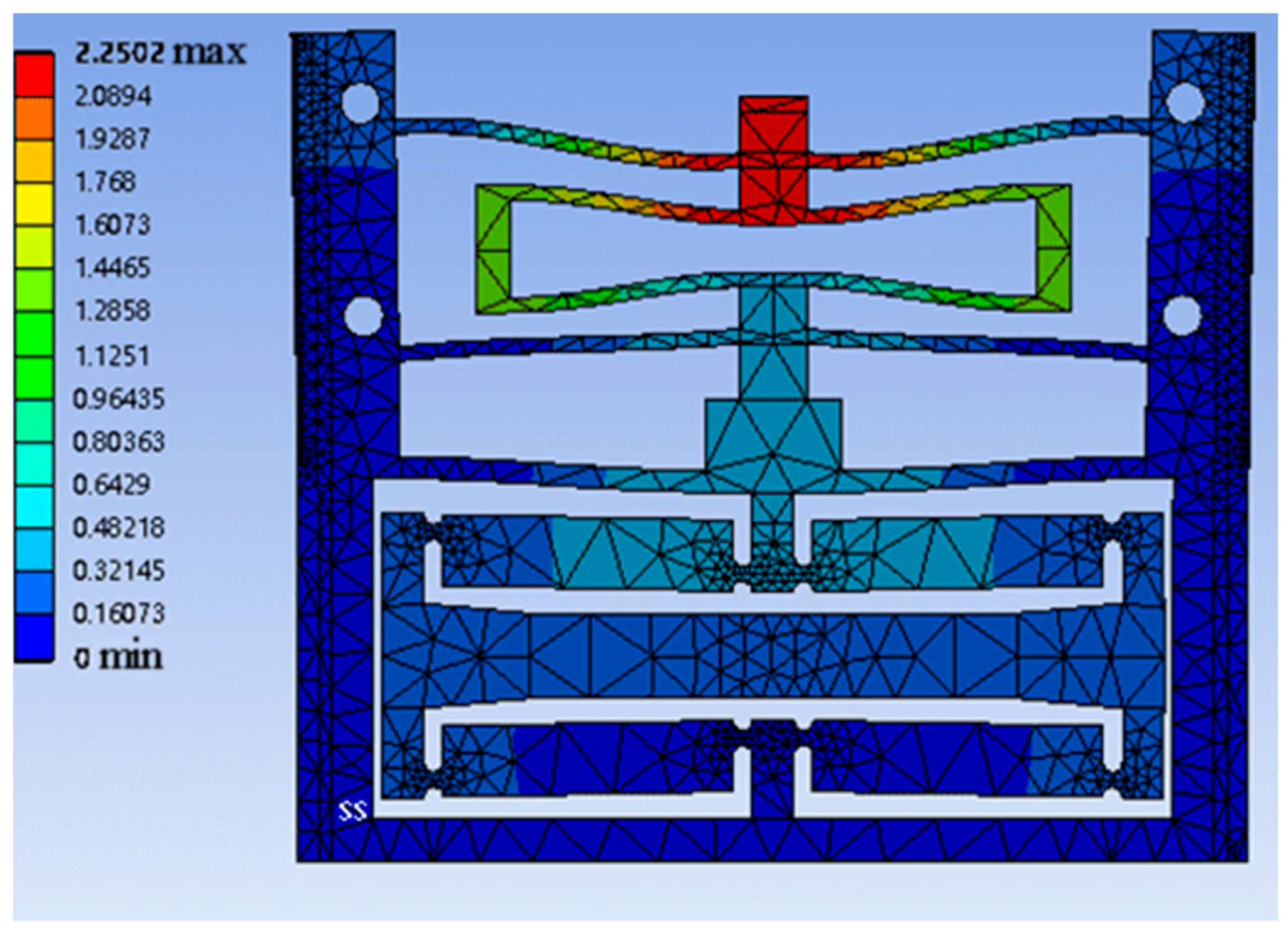


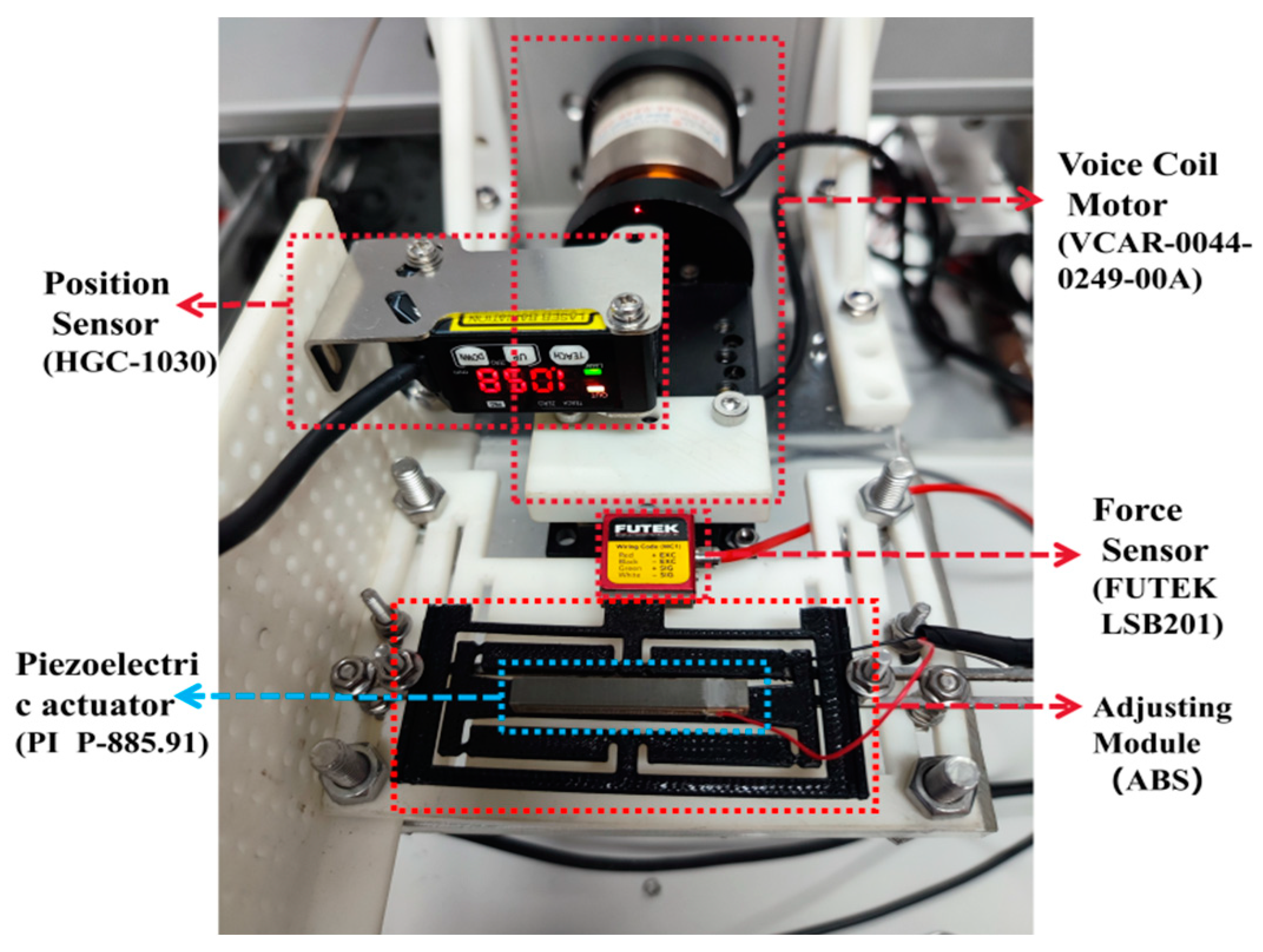

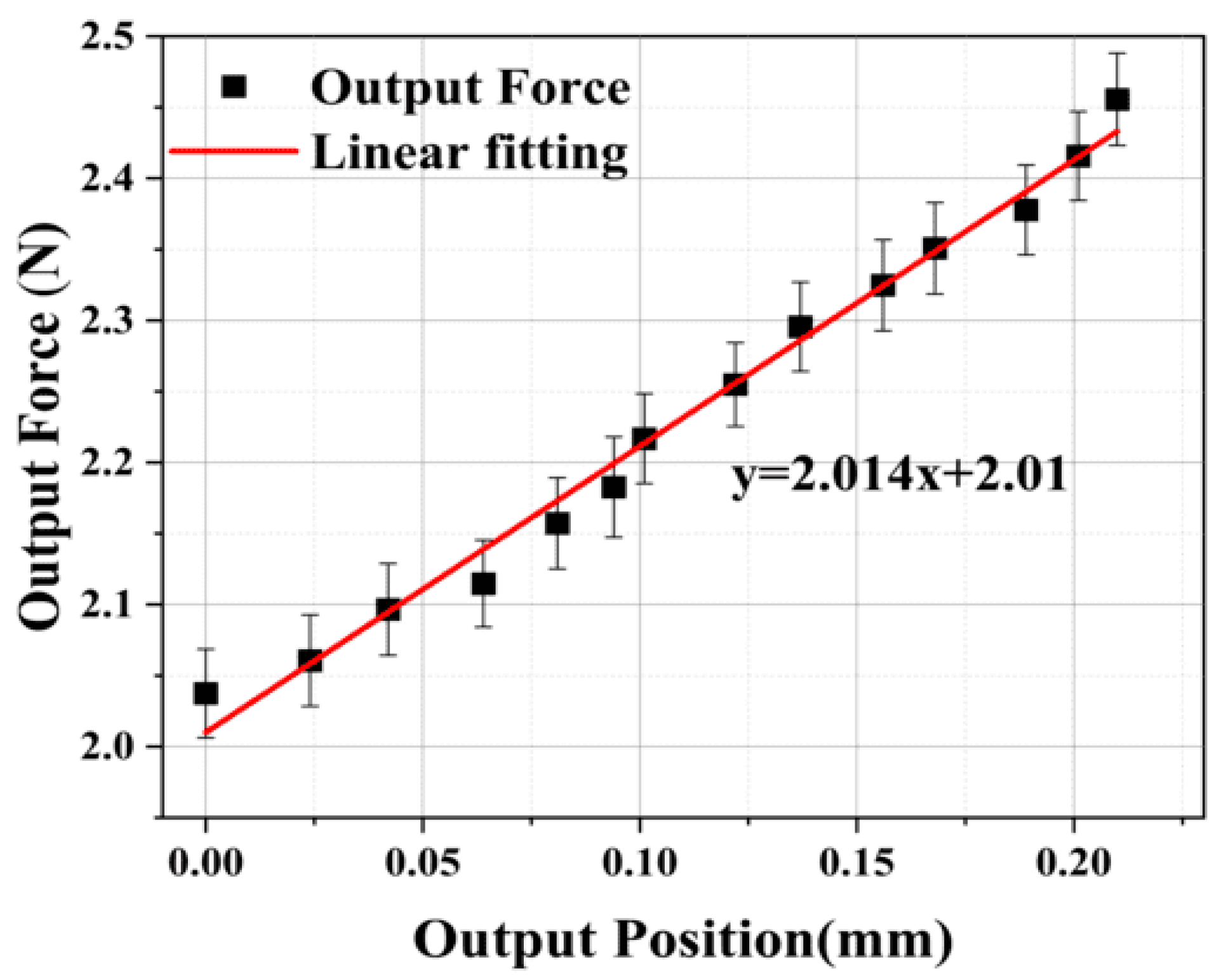
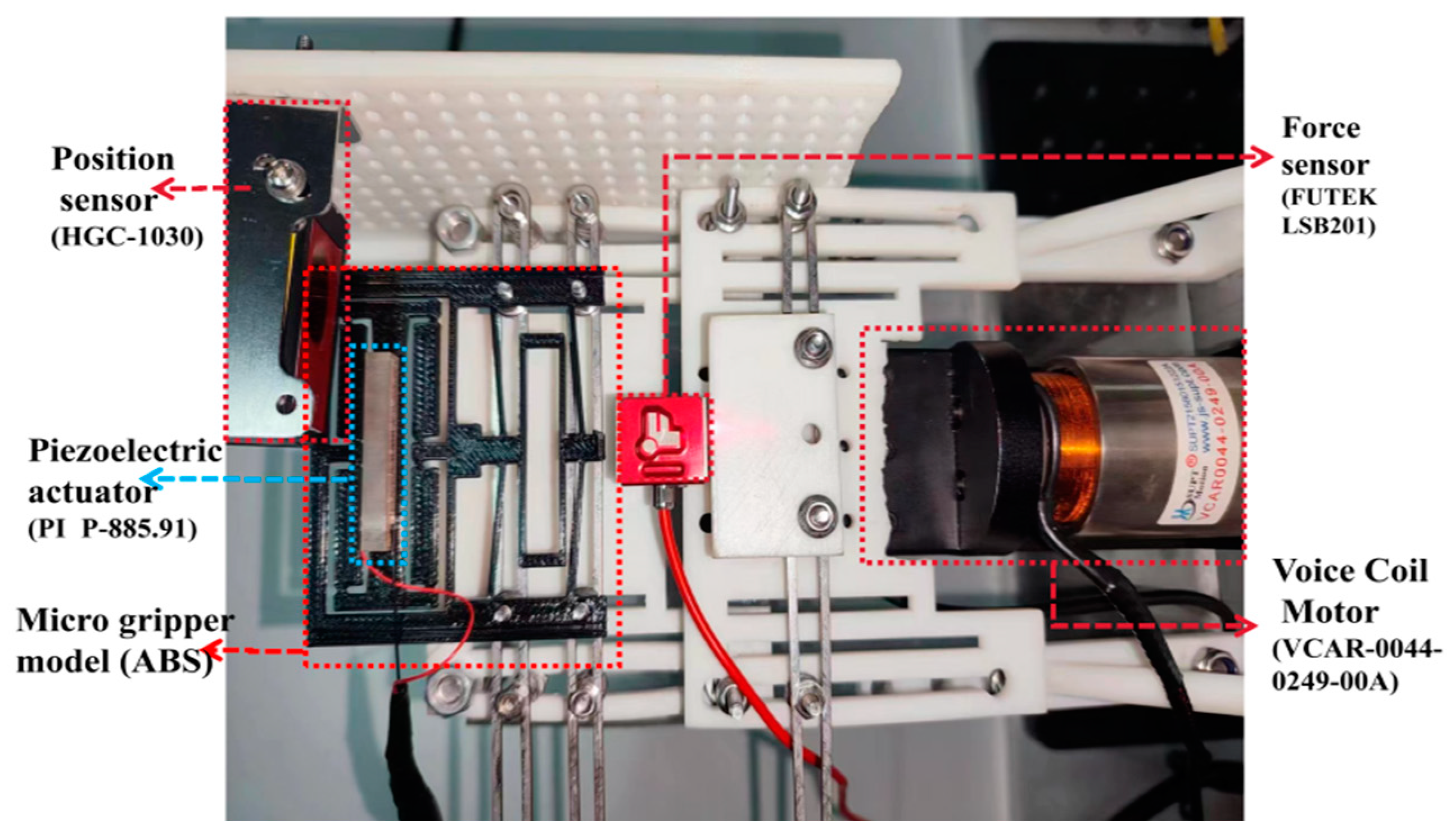
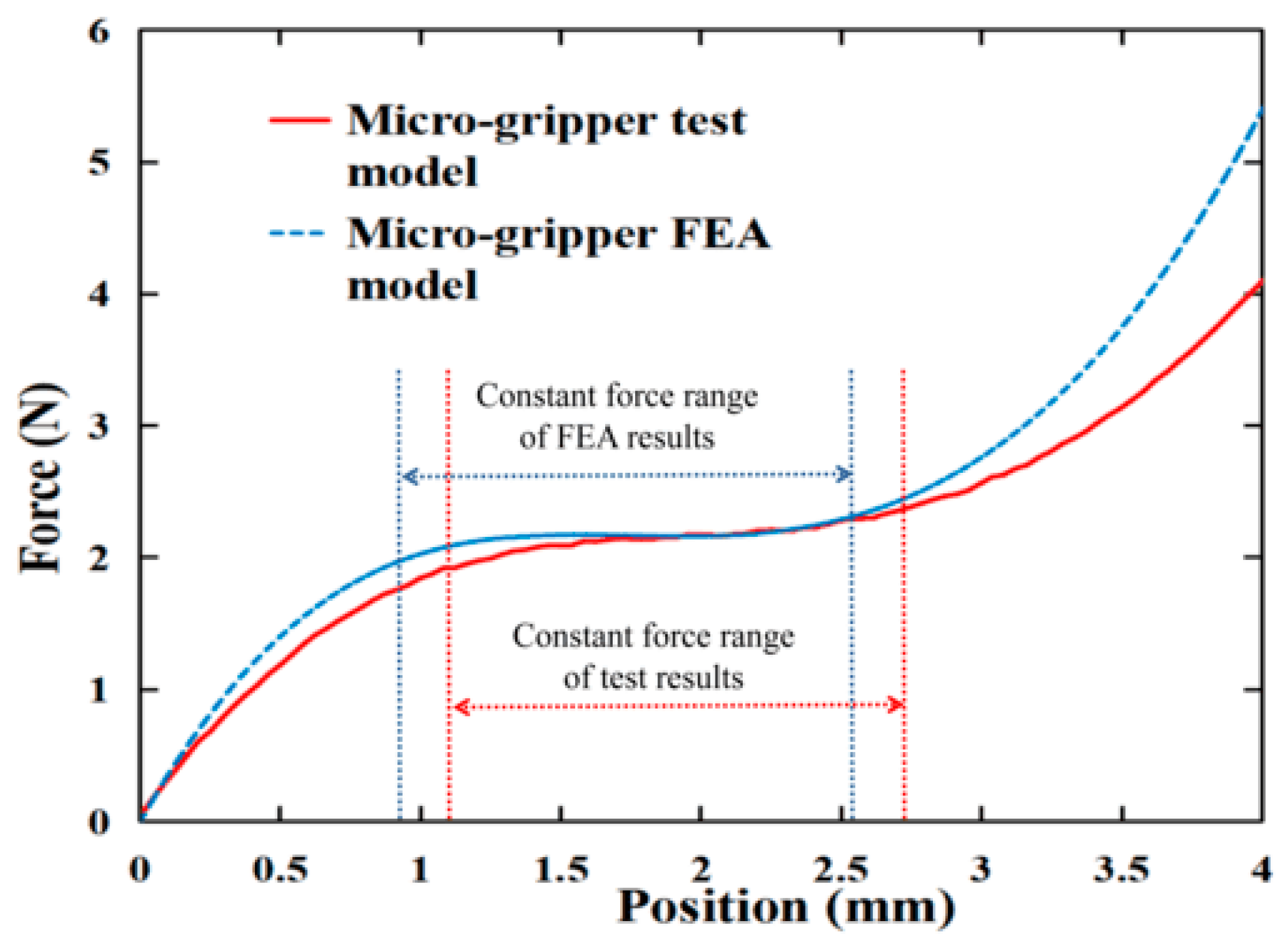
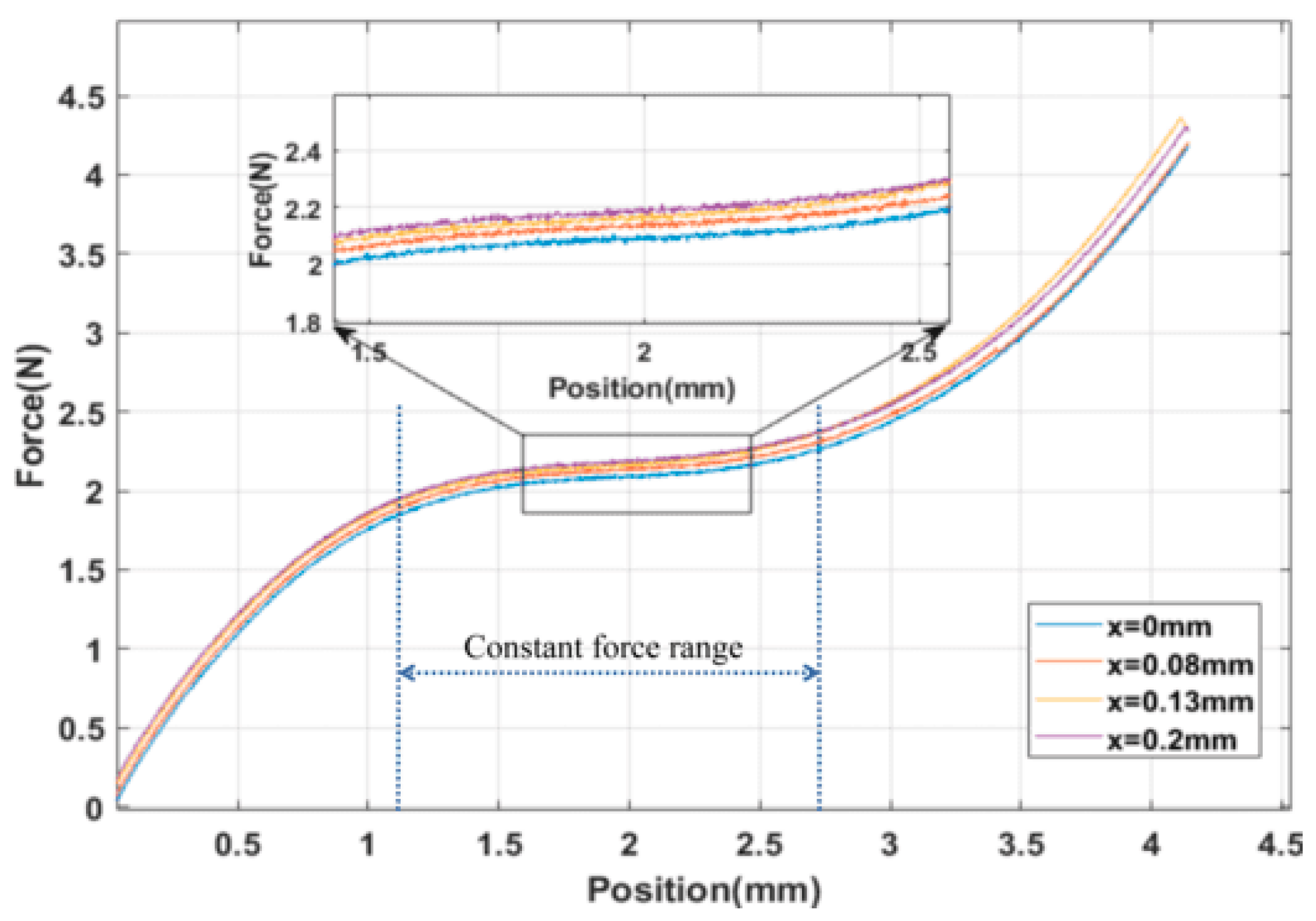
| Parameter | Value | Unit | |
|---|---|---|---|
| Bistable beam | 25 | mm | |
| 3 | mm | ||
| 1.1 | mm | ||
| 5 | ° | ||
| U-shape beam | 20 | mm | |
| 3 | mm | ||
| 1.1 | mm |
| Property | Value | Unit |
|---|---|---|
| Density | 1040 | kg/m3 |
| Young’s Modulus | 2.39 | GPa |
| Poisson’s Ratio | 0.399 | — |
| Bulk Modulus | 3.944 | GPa |
| Shear Modulus | 0.854 | GPa |
| Tensile Yield Strength | 41.4 | MPa |
| Tensile Ultimate Strength | 44.3 | MPa |
| Parameter | Value | Unit |
|---|---|---|
| 1.8 | mm | |
| 5.1 | ° | |
| 1.0 | mm | |
| 16.9 | mm |
Disclaimer/Publisher’s Note: The statements, opinions and data contained in all publications are solely those of the individual author(s) and contributor(s) and not of MDPI and/or the editor(s). MDPI and/or the editor(s) disclaim responsibility for any injury to people or property resulting from any ideas, methods, instructions or products referred to in the content. |
© 2023 by the authors. Licensee MDPI, Basel, Switzerland. This article is an open access article distributed under the terms and conditions of the Creative Commons Attribution (CC BY) license (https://creativecommons.org/licenses/by/4.0/).
Share and Cite
He, J.; Liu, Y.; Yang, C.; Tong, Z.; Wang, G. Design and Evaluation of an Adjustable Compliant Constant-Force Microgripper. Micromachines 2024, 15, 52. https://doi.org/10.3390/mi15010052
He J, Liu Y, Yang C, Tong Z, Wang G. Design and Evaluation of an Adjustable Compliant Constant-Force Microgripper. Micromachines. 2024; 15(1):52. https://doi.org/10.3390/mi15010052
Chicago/Turabian StyleHe, Jiahang, Yinong Liu, Chunbiao Yang, Zongdi Tong, and Guangwei Wang. 2024. "Design and Evaluation of an Adjustable Compliant Constant-Force Microgripper" Micromachines 15, no. 1: 52. https://doi.org/10.3390/mi15010052






